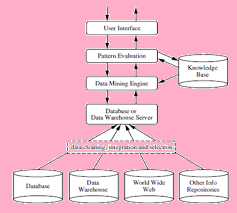Data mining Architecture
Introducation:
Data mining derives its name from the
similarities between searching for valuable business information in a large
database - for example, finding linked products in gigabytes of store scanner
data -- and mining a mountain for a vein of valuable ore. Both processes
require either sifting through an immense amount of material, or intelligently
probing it to find exactly where the value resides. Given databases of
sufficient size and quality, data mining technology can generate new business
opportunities by providing these capabilities
What Is Data Mining?
Data mining refers to extracting or mining knowledge from large amounts of data. The term is actually a misnomer. Thus, data mining should have
been more appropriately named as knowledge mining which emphasis on mining from
large amounts of data.
What is data mining
architecture?
Data mining is a very important process where potentially useful and previously unknown information
is extracted from large volumes of data.
... The major components of any data
mining system is a data source, data warehouse server, data mining engine, pattern
evaluation module, graphical user interface and knowledge base.
What is data mining techniques?
Data Mining Techniques. There are several
major data mining techniques have
been developing and using in data
mining projects recently including association, classification,
clustering, prediction, sequential patterns, and decision tree. We will briefly
examine those data mining
techniques in the following sections.
1. Knowledge Base:
This is the domain knowledge that is used to guide the search evaluate
the interestingness of resulting patterns. Such knowledge can include concept hierarchies,
used to organize attributes or attribute values into different levels of
abstraction. Knowledge such as user beliefs, which can be used to assess a
pattern's interestingness based on its unexpectedness may also be included.
Other examples of domain knowledge are additional interestingness constraints
or thresholds, and metadata (e.g., describing data from multiple heterogeneous
sources).
2. Data Mining Engine:
This is essential to the data mining system and ideally consists of a set
of functional modules for tasks such as characterization, association and correlation analysis, classification, prediction, cluster analysis, outlier
analysis, and evolution analysis.
3. Pattern Evaluation Module:
This component typically employs interestingness measures interacts with
the data mining modules so as to focus the search toward interesting patterns.
It may use interestingness thresholds to filter out discovered patterns.
Alternatively, the pattern evaluation module may be integrated with the mining
module, depending on the implementation of the data mining method used. For
efficient data mining, it is highly recommended to push the evaluation of
pattern interestingness as deep as possible into the mining process as to
confine the search to only the interesting patterns.
4. User interface:
This module communicates between users and the data mining system
allowing the user to interact with the system by specifying a data mining query a task, providing information to help focus the search and performing
exploratory data mining based on the intermediate data mining results. In
addition, this component allows the user to browse database and data warehouse
schemas or data structures, evaluate mined patterns and visualize the patterns
in different forms.

No comments:
Post a Comment